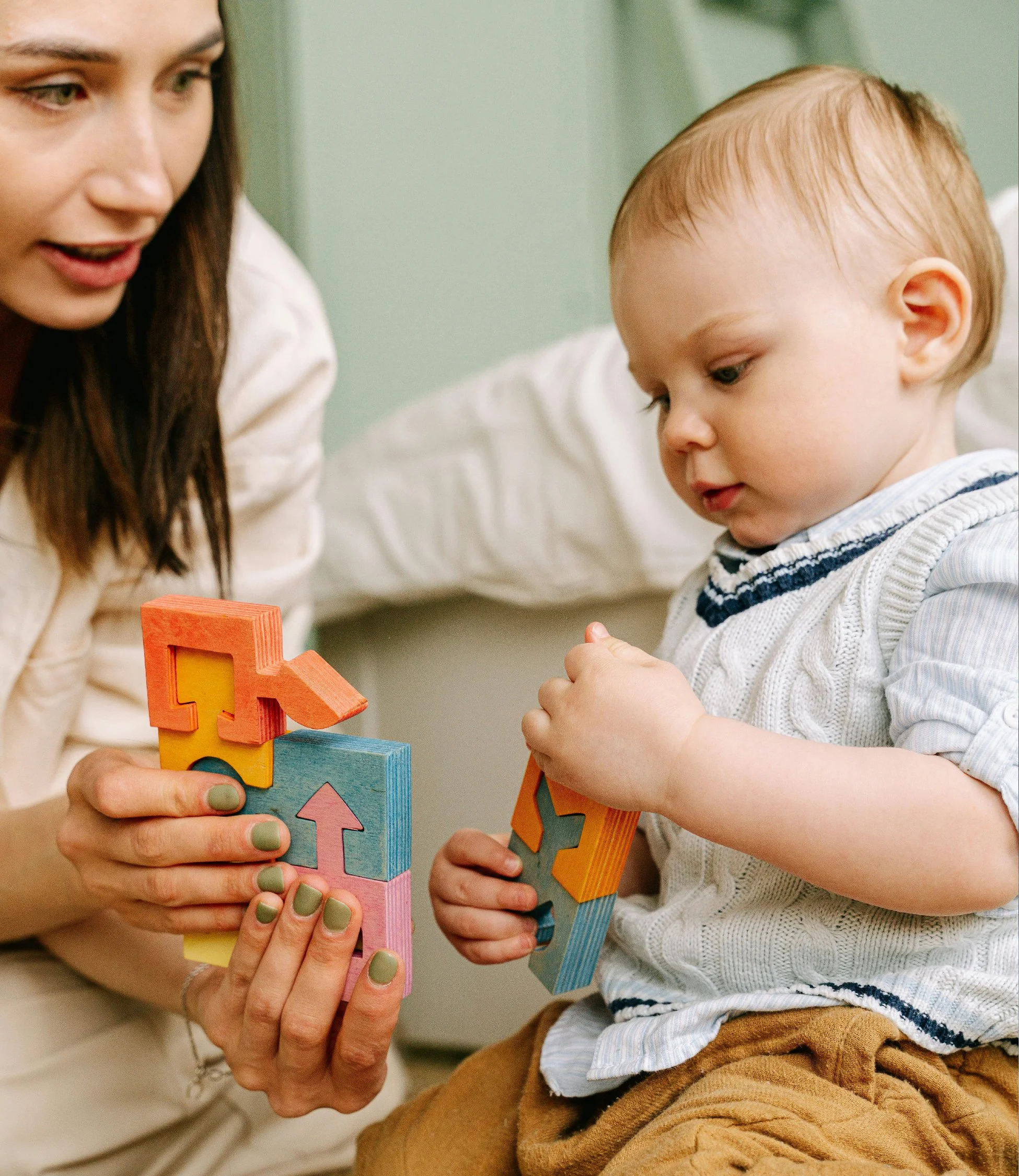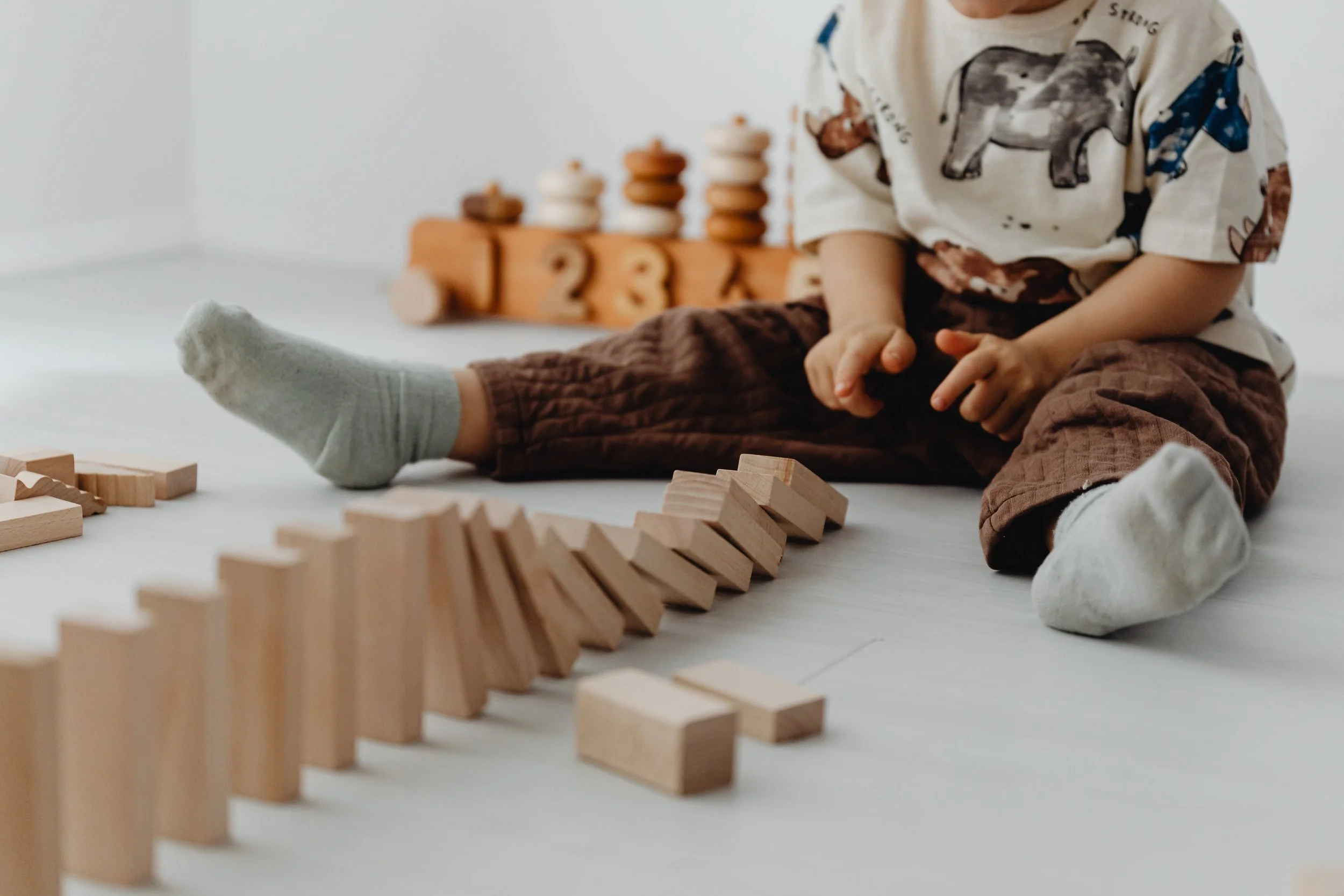Imitation Development: How To Encourage Your Child To Copy Words
Research shows that imitation skills are necessary for first words. So let’s get your child copying you!
In this post, we will break down the developmental steps of imitation, so you know what to expect and can see where your child is at! And, we’ll give you practical ideas for how you can encourage imitation at home.
The Stages of Imitation Development—what to watch for:
Imitation develops in a sequential manner that starts with object imitation and ends with copying words. This is why you see your toddler wave to indicate “hi” before they say the word “hi.” It’s also why a lot of little ones pick up sign language before they say spoken words.
Before your child starts talking, you’ll notice them imitating you in other ways. They might copy housework activities by using a rag to wipe a spill, trying to put a bowl in the dishwasher, talking on the phone, or putting on shoes. Or, they might copy you during play by putting a puzzle piece in a puzzle, sliding a car down a ramp, or throwing a ball.
This is how the imitation hierarchy breaks down. (In other words, it’s what imitation development typically looks like in littles!):
#1 Object Imitation
Object imitation is what happens when your child copies something they’ve seen you do with an object. This could look like pounding on a drum, stirring with a spoon, putting a block in the container, taking a puzzle piece out, or dipping a wand into bubbles.
#2 Body Imitation
Body imitation refers to any movements your child copies. It could be BIG motor movements like jumping, stomping their feet, and clapping. Or it could be smaller motor movements like toddler sign language. Some of our favorite first signs for little ones are more, open, and play!
Related: How To Teach Sign Language To Your Toddler
#3 Oral Imitation
Oral imitation often looks like blowing a kiss, making a surprised face, or chomping like an alligator! It doesn’t require a sound to count, either. (That’s sound imitation, which comes next!)
#4 Sound Imitation
Sound imitation is pretty much what it sounds like: your little one copying the sounds that you or a caregiver makes! This could include:
Animal sounds like meow, baaa, or roar!
Environmental sounds like a car noise (vroom) or popping sound
Exclamatory words like Yay! Uh oh! Wee!
#5 Functional Word Imitation
The final phase in imitation development is when your child copies you when you say functional words, like “dada,” “ball,” “water,” and “dog.” We call these words “functional” because they’re the types of words that ultimately help your child effectively communicate their wants, needs, and thoughts. (Compared to words like “red” or their ABCs, which are more important for the school-aged years, but less important for early communication!)
→ Curious about what other speech and language skills your child is demonstrating and which ones might be coming next? DOWNLOAD OUR FREE TODDLER COMMUNICATION CHECKLIST.
How To Encourage Your Child To Imitate You
Want to help your child move through the stages of imitation development? First, take a look back through the imitation hierarchy and try to figure out both where your child is right now AND where they will likely be headed next.
Got it? Okay, good! Now that you know which stage of imitation development you’re working within, we have some recommendations!
Meet Your Child Where They’re At
Now that you know what stage in the sequence your child is at, start there. Because if your little one isn’t copying motor movements like clapping or reaching their arms up, they won’t be ready to start imitating words they hear you say, either! Once they are consistently imitating you in the ways you’d expect for their level, you can move on to the next one.
Practice Imitation During Play
Play is the work of a child, and it’s one of the most effective ways to see improvement. During play, your little one will be much more motivated to try to copy, simply because they’re having fun! (And we all learn best while we’re having fun!)
If you notice them showing interest in an animal puzzle, you might model animal sounds as they put them in. If they put the cow in, you’d say, “Moooo, says the cow.” Or, when they pick up the chicken, you could say, “Bock bock bock!” Sometimes they’ll surprise you by trying to copy what you do and say!
Copy What THEY’re Doing
Little ones aren’t used to being copied, they’re used to copying you. So when you change it up, they’ll take notice. Because it’s so out of the ordinary for them, it gets their attention!
Copying your child also teaches them the concept of imitation. And it can be a great bridge to getting them to copy you. Think about it: if they start banging on their high chair tray, then you tap on their high chair tray, then they do it again, then you do it again, and you keep going in this back and forth…it becomes hard to tell who is imitating who!
Try Mirror Play
Making funny faces and sounds in the mirror is a great way to practice imitation. Usually, when you’re playing in a mirror, there’s not a lot of distraction. So they can focus on you! Plus, mirrors are easy to come by. They’re there as you wash hands, or maybe even walk down the hallway. Might as well take advantage!
Follow Their Lead
Want your child to imitate you more often? Take notice of their interests! Because just like when they’re having fun, they’re much more likely to imitate if they’re interested in what you’re doing. And, if they’re already good at copying things they’re interested in, try incorporating something new that still leverages that interest.
If they already love moving a train along a track → Push the train under their bed like a tunnel and say, “Choo choo!” Then notice if they try to copy you or not.
If they already love jumping up and down on a trampoline → Jump along with them, add a sound effect like, “Whoa!” or “Wee!” and see what happens!
Remove The Clutter
It can be difficult for kids to focus on imitating you when there are so many other things in their environment, vying for their attention. Making the space around you as simple as possible will help them focus on you and the routine or play activity much more easily!
Activities Kids Love To Imitate
There are certain activities that kids just seem drawn to imitating! We hope this list will spark some ideas of thighs your child might enjoy.
This list is non-exhaustive…but be warned: If you try them all in a day, it may be exhausting! 😅
Spinning In A Circle
Jumping On The Bed
Using Gestures During Book Reading (Ex: Brushing Teeth, Rocking)
Tapping On The Table
Stomping Bubbles
Pushing A Button On A Cause And Effect Toy
Clapping To Songs
Shaking Instruments
Tapping Spoons Together
Jumping
Pretending To Drink From A Cup During Play
Pretending To Eat During Play
Why Some Children Don’t Imitate Right Away
We know these activities typically work because we’ve seen the imitation skills of hundreds of children improve when we apply them in speech therapy. But, if you’ve been following us for any length of time, you know we’re the first to admit that there are times when A+B doesn’t equal C with little ones.
If you’ve done or are doing all these things but you STILL feel like your child’s communication development is hitting a wall, here are a few potential reasons why:
They Struggle With Attention
Are they able to pay attention long enough to watch what you’re doing? Or are they SO busy going from thing to thing, dumping baskets, or pulling items off shelves that it seems like they hardly notice? If it’s more of the latter, you may need to work on that attention piece before expecting them to successfully imitate.
They Have Specific Sensory Needs
If it seems like your child is feeling uncomfortable in their skin, super sensitive to noise, or becomes overwhelmed easily, they might have different sensory needs. They could be constantly fighting sensory overload or seeking extra sensory stimulation to the point where they can’t focus on imitating you or anyone else.
They Have Cognitive Difficulties
Cognitive difficulties could also be a reason why you are not seeing your toddler successfully imitate you. Your child would need to have the cognitive abilities of a 9- to 12-month-old to imitate consistently in the ways we’d expect.
They Have Motor Difficulties
This is a big one! If your toddler has difficulty coordinating the movements of their limbs, they might struggle to imitate certain movements—not because they don’t understand the concept of imitation, but because they have motor difficulties!
If your toddler isn’t imitating sounds and words yet, that could be a motor issue, too. Your toddler might have a hard time articulating—a very complex skill that involves coordinating the lips, tongue, teeth, and palate to say the sound or word they want to say. In this case, it’s not that they don’t have the language, it could just be that they have motor planning difficulties.
If you suspect your child struggles in any of these areas, we recommend reaching out to your pediatrician and possibly even requesting a referral to a developmental pediatrician, a developmental psychologist, or an occupational therapist.
Celebrate The Small Wins!
Your little one is working so hard every day! And we will always encourage you to celebrate their little developmental achievements. They may not be imitating words yet, but are they starting to imitate movements? Or copying a sound every once in a while? If so, that’s awesome and worth celebrating. And at the very least, it lets you know where they’re at in their imitation development and what might come next.
Worried about your toddler’s talking skills? Do they seem frustrated?
We created our TalkToddler course to make getting the support your child needs and deserves super simple. When you join, we walk you through step-by step strategies to help your child talk and communicate more, while decreasing frustration for both of you! We recommend that families be proactive. Language development happens so fast during these early years, which is why it’s important to “support and see” not “wait and see” when it comes to your toddler’s development.


